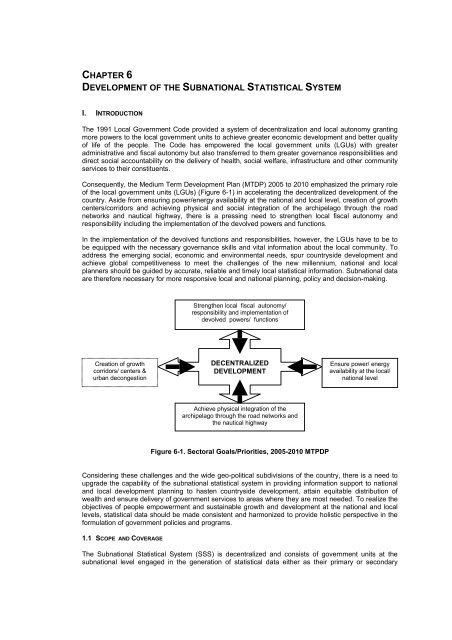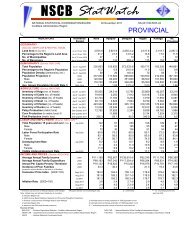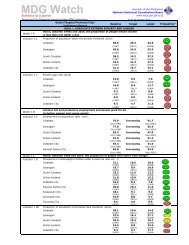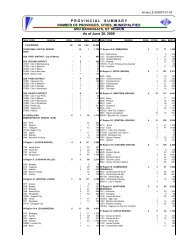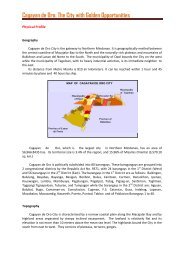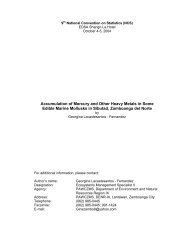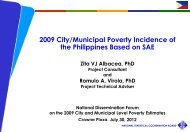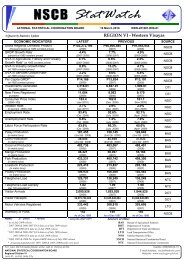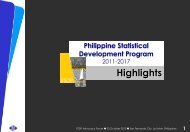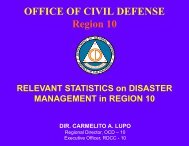chapter 6 development of the subnational statistical system - NSCB
chapter 6 development of the subnational statistical system - NSCB
chapter 6 development of the subnational statistical system - NSCB
- No tags were found...
Create successful ePaper yourself
Turn your PDF publications into a flip-book with our unique Google optimized e-Paper software.
CHAPTER 6DEVELOPMENT OF THE SUBNATIONAL STATISTICAL SYSTEMI. INTRODUCTIONThe 1991 Local Government Code provided a <strong>system</strong> <strong>of</strong> decentralization and local autonomy grantingmore powers to <strong>the</strong> local government units to achieve greater economic <strong>development</strong> and better quality<strong>of</strong> life <strong>of</strong> <strong>the</strong> people. The Code has empowered <strong>the</strong> local government units (LGUs) with greateradministrative and fiscal autonomy but also transferred to <strong>the</strong>m greater governance responsibilities anddirect social accountability on <strong>the</strong> delivery <strong>of</strong> health, social welfare, infrastructure and o<strong>the</strong>r communityservices to <strong>the</strong>ir constituents.Consequently, <strong>the</strong> Medium Term Development Plan (MTDP) 2005 to 2010 emphasized <strong>the</strong> primary role<strong>of</strong> <strong>the</strong> local government units (LGUs) (Figure 6-1) in accelerating <strong>the</strong> decentralized <strong>development</strong> <strong>of</strong> <strong>the</strong>country. Aside from ensuring power/energy availability at <strong>the</strong> national and local level, creation <strong>of</strong> growthcenters/corridors and achieving physical and social integration <strong>of</strong> <strong>the</strong> archipelago through <strong>the</strong> roadnetworks and nautical highway, <strong>the</strong>re is a pressing need to streng<strong>the</strong>n local fiscal autonomy andresponsibility including <strong>the</strong> implementation <strong>of</strong> <strong>the</strong> devolved powers and functions.In <strong>the</strong> implementation <strong>of</strong> <strong>the</strong> devolved functions and responsibilities, however, <strong>the</strong> LGUs have to be tobe equipped with <strong>the</strong> necessary governance skills and vital information about <strong>the</strong> local community. Toaddress <strong>the</strong> emerging social, economic and environmental needs, spur countryside <strong>development</strong> andachieve global competitiveness to meet <strong>the</strong> challenges <strong>of</strong> <strong>the</strong> new millennium, national and localplanners should be guided by accurate, reliable and timely local <strong>statistical</strong> information. Subnational dataare <strong>the</strong>refore necessary for more responsive local and national planning, policy and decision-making.Streng<strong>the</strong>n local fiscal autonomy/responsibility and implementation <strong>of</strong>devolved powers/ functionsCreation <strong>of</strong> growthcorridors/ centers &urban decongestionDECENTRALIZEDDEVELOPMENTEnsure power/ energyavailability at <strong>the</strong> local/national levelAchieve physical integration <strong>of</strong> <strong>the</strong>archipelago through <strong>the</strong> road networks and<strong>the</strong> nautical highwayFigure 6-1. Sectoral Goals/Priorities, 2005-2010 MTPDPConsidering <strong>the</strong>se challenges and <strong>the</strong> wide geo-political subdivisions <strong>of</strong> <strong>the</strong> country, <strong>the</strong>re is a need toupgrade <strong>the</strong> capability <strong>of</strong> <strong>the</strong> <strong>subnational</strong> <strong>statistical</strong> <strong>system</strong> in providing information support to nationaland local <strong>development</strong> planning to hasten countryside <strong>development</strong>, attain equitable distribution <strong>of</strong>wealth and ensure delivery <strong>of</strong> government services to areas where <strong>the</strong>y are most needed. To realize <strong>the</strong>objectives <strong>of</strong> people empowerment and sustainable growth and <strong>development</strong> at <strong>the</strong> national and locallevels, <strong>statistical</strong> data should be made consistent and harmonized to provide holistic perspective in <strong>the</strong>formulation <strong>of</strong> government policies and programs.1.1 SCOPE AND COVERAGEThe Subnational Statistical System (SSS) is decentralized and consists <strong>of</strong> government units at <strong>the</strong><strong>subnational</strong> level engaged in <strong>the</strong> generation <strong>of</strong> <strong>statistical</strong> data ei<strong>the</strong>r as <strong>the</strong>ir primary or secondary
Philippine Statistical Development Program, 2005-2010Meanwhile, <strong>the</strong> Regional/Provincial Statistical Coordination Committee (RSCC/PSCC) directsand guides <strong>statistical</strong> <strong>development</strong> activities at <strong>the</strong> <strong>subnational</strong> level to ensure <strong>the</strong> generation <strong>of</strong>statistics needed in <strong>the</strong> preparation <strong>of</strong> local <strong>development</strong> and monitoring plans in eachregion/province. Specifically, <strong>the</strong> powers and functions <strong>of</strong> <strong>the</strong> committee are: (a) to oversee <strong>the</strong>implementation in <strong>the</strong> region <strong>of</strong> policy decisions made by <strong>the</strong> <strong>NSCB</strong>; (b) to recommend policydecisions affecting <strong>the</strong> <strong>development</strong> <strong>of</strong> <strong>the</strong> region and <strong>the</strong> local level to <strong>the</strong> <strong>NSCB</strong>; (c) toresolve <strong>statistical</strong> problems and issues peculiar to <strong>the</strong> region and local level and institutemeasures to streng<strong>the</strong>n <strong>the</strong> capability <strong>of</strong> <strong>the</strong> region and local levels; and (d) to create interagency<strong>statistical</strong> sub-committees or task forces.Since overall planning in <strong>the</strong> region is vested in <strong>the</strong> Regional Development Council, <strong>the</strong> RSCC,which is composed <strong>of</strong> top <strong>of</strong>ficials <strong>of</strong> various regional line agencies and LGUs, isadministratively attached to <strong>the</strong> Council to ensure responsiveness <strong>of</strong> <strong>the</strong> SSS to <strong>the</strong>requirements <strong>of</strong> this planning body. A representative from <strong>the</strong> private sector, e.g. nongovernmentalorganizations (NGOs), is included as a member <strong>of</strong> <strong>the</strong> committee, consideringthat <strong>the</strong> role NGOs in <strong>the</strong> <strong>development</strong> process has likewise been expanded. The <strong>NSCB</strong>Executive Board also provides overall guidance to <strong>the</strong> Regional Statistical CoordinationCommittees (RSCCs).• Statistical Coordination MechanismsStatistical coordination mechanisms aim to harmonize efforts <strong>of</strong> concerned agencies to bringabout an integrated and coherent <strong>subnational</strong> <strong>statistical</strong> <strong>system</strong> (SSS). The mechanisms forcoordination, which are <strong>the</strong> same as those prescribed by <strong>the</strong> <strong>NSCB</strong> at <strong>the</strong> national level, areadopted or replicated at <strong>the</strong> regional/local level. These are: (a) <strong>statistical</strong> programming through<strong>the</strong> multi-year <strong>subnational</strong> <strong>statistical</strong> <strong>development</strong> program (SSDP), regional/local <strong>statistical</strong>calendar, and monitoring <strong>of</strong> <strong>the</strong> program and calendar; (b) funds programming; (c) formsreview and clearance <strong>system</strong>; and (d) standard concepts, classification <strong>system</strong>s andtechniques.The multi-year SSDP sets <strong>the</strong> direction for <strong>the</strong> <strong>development</strong> <strong>of</strong> <strong>the</strong> SSS by addressingprevailing problems and issues and meetings <strong>the</strong> information needs <strong>of</strong> each <strong>development</strong>sector at <strong>the</strong> <strong>subnational</strong> level. In particular, it consists <strong>of</strong> various strategies and activities tosolve bottlenecks affecting <strong>the</strong> capability <strong>of</strong> <strong>the</strong> SSS to respond to <strong>the</strong> needs <strong>of</strong> <strong>the</strong> clientele.The review <strong>of</strong> <strong>the</strong> <strong>statistical</strong> budget proposal <strong>of</strong> agencies at <strong>the</strong> region/local level provides <strong>the</strong>necessary resources for priority <strong>statistical</strong> activities. The manner through which budgets for<strong>statistical</strong> activities <strong>of</strong> <strong>subnational</strong> agencies are reviewed is consistent with <strong>the</strong> schedulesprescribed under <strong>the</strong> synchronized planning-programming-budgeting <strong>system</strong>. This allowscloser linkages between <strong>statistical</strong> planning and funds programming.The forms and clearance <strong>system</strong>, which has been implemented since 1988 by <strong>the</strong> <strong>NSCB</strong> at <strong>the</strong>national level, is prescribed at <strong>the</strong> <strong>subnational</strong> level. The <strong>system</strong> is envisioned to eliminateduplication <strong>of</strong> <strong>statistical</strong> data collection through survey/censuses, minimize <strong>the</strong> burden placedupon responding establishments, households and o<strong>the</strong>r entities and ensure <strong>the</strong> technicaladequacy <strong>of</strong> <strong>the</strong> survey design.The adoption <strong>of</strong> standard concepts, classification <strong>system</strong>s and techniques at <strong>the</strong> <strong>subnational</strong>level ensures data compatibility and consistency. The RSCC is tasked to oversee <strong>the</strong> adoption<strong>of</strong> <strong>the</strong>se in <strong>the</strong> region and at <strong>the</strong> local level.Subnational Data Production and Dissemination SystemThis component covers techniques, procedures and methods <strong>of</strong> data production, documentation,storage and dissemination employed by agencies at <strong>the</strong> regional/local level. Improvements in <strong>the</strong>seactivities will enable <strong>the</strong> <strong>system</strong> to provide information support for more effective decentralized planningand policy-making. A refocusing <strong>of</strong> <strong>the</strong> data production activities giving priority to <strong>the</strong> generation <strong>of</strong> smallarea statistics to address <strong>the</strong> areas <strong>of</strong> concern <strong>of</strong> <strong>the</strong> Regional/ Provincial Development Plan is <strong>the</strong>reforenecessary. Data production <strong>system</strong>s can be developed/improved through <strong>statistical</strong> manpower<strong>development</strong> and <strong>statistical</strong> technology <strong>development</strong>. To effectively carry out <strong>the</strong>se major activities,operating guidelines are prepared and monitoring visits by central <strong>of</strong>fice staff personnel are regularlyconducted. The local visits also aim to determine <strong>the</strong> progress and status <strong>of</strong> implementation <strong>of</strong> <strong>statistical</strong>activities and ensure <strong>the</strong> early solution <strong>of</strong> emerging problems/bottlenecks.Development <strong>of</strong> <strong>the</strong> Subnational Statistical System 6-3
Philippine Statistical Development Program, 2005-2010Subnational Human Resource DevelopmentBetter and more innovative training for <strong>the</strong> technical upgrading <strong>of</strong> <strong>statistical</strong> personnel at <strong>the</strong> regionallevel and in local government units can help achieve <strong>the</strong> twin objectives <strong>of</strong> closing <strong>the</strong> gap between andavailable trained technical manpower resources and upgrading <strong>the</strong> quality <strong>of</strong> <strong>statistical</strong> manpower atthose levels. Among <strong>the</strong> specific courses <strong>of</strong> action along this line are: graduate training andpr<strong>of</strong>essionalization; short-term training programs; career <strong>system</strong> for <strong>statistical</strong> personnel;seminar/workshops; and conferences and special studies on manpower <strong>development</strong>.Under <strong>the</strong> graduate program, <strong>statistical</strong> workers and faculty members <strong>of</strong> academic institutions at <strong>the</strong>regional and subregional levels are provided with opportunities to pursue masteral/ doctoral programs instatistics. Non-degree short-term and general/specialized training courses are small area statistics,exploratory data analysis, estimation methodologies based on incomplete or small-area data, regionalforecasting, model-building for macro-planning, <strong>statistical</strong> data management, research design and<strong>statistical</strong> report writing. The specific training courses depend on <strong>the</strong> level <strong>of</strong> <strong>the</strong> <strong>statistical</strong> worker, i.e.primary statistician, intermediate statistician and pr<strong>of</strong>essional statistician, and based on <strong>the</strong> results <strong>of</strong> atraining needs assessment conducted by <strong>the</strong> SCU staff. The Statistical Research Training Center(SRTC) is <strong>the</strong> lead agency in conducting <strong>the</strong> non-degree training programs.A career <strong>system</strong> for <strong>statistical</strong> personnel at <strong>the</strong> <strong>subnational</strong> level is a means for attracting pr<strong>of</strong>essionalstatisticians into <strong>the</strong> government /public service and promoting statistics as pr<strong>of</strong>ession among <strong>the</strong><strong>subnational</strong> personnel. This would also help reduce <strong>the</strong> high turnover rate <strong>of</strong> statisticians in <strong>the</strong> service.The career <strong>system</strong>, which includes a Pr<strong>of</strong>essional Certification Program and accreditation <strong>of</strong> education,training and experience, may eventually widen <strong>the</strong> <strong>statistical</strong> manpower base at <strong>the</strong> local level.Seminars/workshops are expected to augment previously acquired training and contribute in <strong>the</strong>pr<strong>of</strong>essionalization <strong>of</strong> <strong>statistical</strong> personnel. Likewise, regular conferences are held to update <strong>statistical</strong>personnel on recent <strong>development</strong>s in statistics and o<strong>the</strong>r fields. Of equal value are observationtours/visits to o<strong>the</strong>r countries in order to know more about <strong>the</strong>ir styles on <strong>subnational</strong> <strong>statistical</strong>coordination and <strong>development</strong>.Continuing studies on manpower <strong>development</strong> are also done to assess <strong>the</strong> impact <strong>of</strong> training programsto provide vital inputs into <strong>the</strong> design <strong>of</strong> new and more effective manpower <strong>development</strong> programs for<strong>subnational</strong> <strong>statistical</strong> personnel. To conduct <strong>the</strong>se studies, <strong>the</strong> assistance <strong>of</strong> <strong>the</strong> academe,international/national research institutions and o<strong>the</strong>r pr<strong>of</strong>essional groups will be solicited.Statistical Research and DevelopmentStatistical methodologies used in <strong>the</strong> generation and dissemination <strong>of</strong> local-level <strong>statistical</strong> data arecontinuously reviewed and assessed. Appropriate, new and innovative methodologies are developedand adopted for more efficient data production and dissemination. These are three specific areasrequiring careful review namely: (a) <strong>the</strong> <strong>system</strong> <strong>of</strong> small area statistics; (b) research and <strong>development</strong> (R& D) on local statistics; and (c) <strong>subnational</strong> economic and social accounts and indicator <strong>system</strong>.The <strong>system</strong> <strong>of</strong> small area statistics (SAS) has become indispensable in <strong>the</strong> light <strong>of</strong> decentralizedgovernment functions. Activities to make available local-level data from existing national-level <strong>statistical</strong>undertakings as well as those intended to generate SAS are <strong>the</strong>refore given priority. To resolveproblems associated with uncoordinated data production, data generation procedures in <strong>the</strong> region andlocal levels are analyzed and improved. An efficient monitoring and evaluation <strong>system</strong> is likewisedeveloped to address <strong>the</strong>se problems which, among o<strong>the</strong>rs, include data gaps, unreliability, duplication,lack <strong>of</strong> timeliness and inconsistency <strong>of</strong> data.Statistical R & D is a critical factor in <strong>the</strong> fur<strong>the</strong>rance <strong>of</strong> <strong>the</strong> desired improvements in <strong>the</strong> SSS. Among<strong>the</strong> r & d activities at <strong>the</strong> <strong>subnational</strong> level are researches on <strong>the</strong> generation <strong>of</strong> small-area statistics and<strong>the</strong> most cost-effective <strong>statistical</strong> methodologies, survey instruments, data collection and retrievalprocesses.In response to <strong>the</strong> demands <strong>of</strong> local planning and policy formulation, <strong>the</strong>re is a need to supplement andwiden <strong>the</strong> base for economic analysis by including an economic and social accounts indictor <strong>system</strong>.This <strong>system</strong> provides <strong>the</strong> framework for assessing <strong>the</strong> quality <strong>of</strong> available small area statistics andimproving <strong>the</strong> SSS.6-4 Development <strong>of</strong> <strong>the</strong> Subnational Statistical System
Philippine Statistical Development Program, 2005-20101.3 DATA SOURCESStatistics with regional, provincial, city and municipal disaggregation used to be generated by <strong>the</strong>central/regional/field <strong>of</strong>fices <strong>of</strong> practically all <strong>of</strong> <strong>the</strong> national government agencies. These <strong>subnational</strong>agencies produce ei<strong>the</strong>r primary statistics or data by-products <strong>of</strong> <strong>the</strong>ir administrative or regulatoryfunctions.However, with <strong>the</strong> devolution <strong>of</strong> <strong>the</strong> powers and functions <strong>of</strong> line departments in 1993 on <strong>the</strong> delivery <strong>of</strong>health, social welfare and infrastructure services pursuant to <strong>the</strong> 1991 Local Government Code, <strong>the</strong>local health and social welfare statistics are now generated by <strong>the</strong> local government units. Thus, <strong>the</strong>local government units at <strong>the</strong> provincial, city, municipal and barangay levels and many o<strong>the</strong>r agencies <strong>of</strong><strong>the</strong> government at <strong>the</strong> subregional level are now a rich source <strong>of</strong> data generated from administrativerecords or through ad-hoc surveys.Meanwhile, some major <strong>statistical</strong> agencies still produce primary statistics through censuses and nationwidesurveys. These are <strong>the</strong> National Statistics Office (NSO) and <strong>the</strong> Bureau <strong>of</strong> Agricultural Statistics(BAS). The NSO has comprehensive network or field personnel at <strong>the</strong> municipal, provincial and regionallevels which conducts, on a regular basis, censuses and surveys <strong>of</strong> establishments and households.From <strong>the</strong>se activities, demographic, labor force and establishments data are obtained.The BAS, on <strong>the</strong> o<strong>the</strong>r hand, has provincial operation centers supervised by Survey OperationsCoordinating Offices based at <strong>the</strong> Central <strong>of</strong>fice. The BAS conducts agricultural surveys <strong>of</strong> palay andcorn and commercial and o<strong>the</strong>r crops, livestock and poultry, fishery and forestry. There are o<strong>the</strong>ragencies that occasionally collect data through special surveys in answer to a particular need.There are government agencies that compile data as by-products <strong>of</strong> <strong>the</strong>ir administrative or regulatoryfunctions. These agencies include <strong>the</strong> following various line departments and <strong>the</strong> bureaus/<strong>of</strong>fices under<strong>the</strong>m at <strong>the</strong> <strong>subnational</strong> level: Department <strong>of</strong> Agrarian Reform (DAR); Department <strong>of</strong> Agriculture (DA);Department <strong>of</strong> Budget and Management (DBM); Department <strong>of</strong> Education, Culture and Sports (DECS);Department <strong>of</strong> Health (DOH); Department <strong>of</strong> Justice (DOJ); Department <strong>of</strong> Social Welfare andDevelopment (DSWD); Department <strong>of</strong> Tourism (DOT); Department <strong>of</strong> Public Works and Highways(DPWH); Department <strong>of</strong> Labor and Employment (DOLE); Department <strong>of</strong> Environment and NaturalResources (DENR); Department <strong>of</strong> Trade and Industry (DTI); Department <strong>of</strong> Local Government (DLG);and <strong>the</strong> Department <strong>of</strong> Transportation and Communications (DOTC).The National Statistical Coordination Board (<strong>NSCB</strong>) compiles The Gross Regional Domestic Product(GRDP) which is <strong>the</strong> regional dimension <strong>of</strong> <strong>the</strong> Philippine System <strong>of</strong> National Accounts (PSNA). TheGRDP gives an indication <strong>of</strong> <strong>the</strong> extent to which <strong>the</strong> regions are economically developing.II. SITUATIONAL ANALYSIS, 1999-20042.1 STATISTICAL DEVELOPMENTSStreng<strong>the</strong>ned local <strong>statistical</strong> <strong>system</strong>The need to develop <strong>the</strong> <strong>subnational</strong> <strong>statistical</strong> <strong>system</strong> has long been recognized even at <strong>the</strong> onset <strong>of</strong><strong>the</strong> decentralization thrust <strong>of</strong> government. Among <strong>the</strong> notable activities and outputs in <strong>the</strong> past planperiod include:• Expansion <strong>of</strong> Regional/Provincial Statistical Coordination Committees and establishment <strong>of</strong>new <strong>NSCB</strong> Regional DivisionsAlbeit limited to areas where <strong>the</strong> <strong>NSCB</strong> has been provided meager resources to establish andoperate a Regional Unit and NSIC branch, some significant improvements have beenintroduced and institutionalized towards <strong>the</strong> generation and application <strong>of</strong> statistics at <strong>the</strong> locallevels. Thus, <strong>the</strong> period 1999 to 2004 saw <strong>the</strong> expansion <strong>of</strong> <strong>the</strong> Regional StatisticalCoordination Committees (RSCCs) through <strong>the</strong> new <strong>NSCB</strong> Regional Divisions in Regions IV-A, IX, X, and XI. Likewise, <strong>the</strong> Provincial Statistical Coordination Committees (PrSCCs) inSaranggani and North Cotabato had been established. In 2005, <strong>the</strong> only remaining areaswithout <strong>the</strong> <strong>NSCB</strong> presence were in Regions II, III, IV-B, VII, Caraga and ARMM.Development <strong>of</strong> <strong>the</strong> Subnational Statistical System 6-5
Philippine Statistical Development Program, 2005-2010Realizing <strong>the</strong> importance <strong>of</strong> accurate and reliable statistics to guide local <strong>development</strong> planningand policy formulation, <strong>the</strong> Regional Development Councils (RDC) <strong>of</strong> Regions II, III, VII, andCaraga which oversee and spearhead economic <strong>development</strong> in <strong>the</strong>se areas have formallyrequested <strong>the</strong> <strong>NSCB</strong>, <strong>the</strong> Senate, <strong>the</strong> National Economic Development Authority (NEDA)copy furnish <strong>the</strong>ir Congressmen and <strong>the</strong> DBM to establish an <strong>NSCB</strong> regional <strong>statistical</strong>coordination units in <strong>the</strong>se regions.• Development and Updating <strong>of</strong> Local Standards and Classification SystemStatistical work has long been guided by and is closely associated with standards. Thesestandards are designed to ensure uniformity and comparability <strong>of</strong> statistics not only within <strong>the</strong>country but with o<strong>the</strong>r nations as well. Classifications <strong>system</strong>s are a prime example <strong>of</strong>standards usually with international origin or reference but which have been customized to <strong>the</strong>country’s realistic situation and aligned with prevailing or emerging domestic and globaleconomic trends and technological changes.At <strong>the</strong> <strong>subnational</strong> level, continuous quarterly updating <strong>of</strong> <strong>the</strong> Philippine Standard GeographicCode is being undertaken by <strong>the</strong> <strong>NSCB</strong>. Updated Philippine Standard Geographic Code(PSGC). The PSGC is an important set <strong>of</strong> standards in that changes <strong>the</strong>reto affect most georeferenceddatabases and <strong>system</strong>s as well as program and policy targets <strong>of</strong> government. Theupdated masterlist <strong>of</strong> barangays, municipalities, cities, provinces and regions wasdisseminated to concerned government agencies in print and electronic forms, diskette/CDROM and thru <strong>the</strong> <strong>NSCB</strong> website.Production/generation <strong>of</strong> <strong>subnational</strong>-level data• Estimation <strong>of</strong> Gross Regional Domestic Product and Provincial Product AccountsThe <strong>NSCB</strong> released in July 2004 <strong>the</strong> estimates <strong>of</strong> <strong>the</strong> 2003 GRDP based on <strong>the</strong> new regionalconfiguration pursuant to Executive Order No. 36 which reconfigured <strong>the</strong> Mindanao regionsand Executive Order No. 103 which split <strong>the</strong> <strong>the</strong>n Sou<strong>the</strong>rn Tagalog Region intoCALABARZON and MIMAROPA as well as transferred <strong>the</strong> Aurora province to Central Luzon.Likewise, initial activities were also undertaken during <strong>the</strong> period for <strong>the</strong> estimation <strong>of</strong> <strong>the</strong>provincial product accounts for interested provincial local government units building on <strong>the</strong>experiences and gains on <strong>the</strong> estimation <strong>of</strong> <strong>the</strong> Palawan Provincial Product Accounts.• Development and generation <strong>of</strong> local poverty statisticsWith <strong>the</strong> release <strong>of</strong> <strong>the</strong> preliminary results <strong>of</strong> <strong>the</strong> 2003 Family Income and Expenditure Survey(FIES) <strong>of</strong> <strong>the</strong> NSO, <strong>the</strong> <strong>NSCB</strong> produced <strong>the</strong> initial estimates <strong>of</strong> <strong>the</strong> regional food thresholds forCY 2003 and an analysis <strong>of</strong> regional poverty statistics.Moreover, with assistance from <strong>the</strong> World Bank, <strong>the</strong> <strong>NSCB</strong> formulated a methodology forestimating provincial poverty for specific provinces in <strong>the</strong> country. The methodology is aimedat providing a local dimension to <strong>the</strong> existing national and regional level poverty statistics inresponse to increasing demand from local executives and planners for a tool to monitor povertyalleviation initiatives at <strong>the</strong> local level.Meanwhile, to address <strong>the</strong> data needs at <strong>the</strong> provincial and municipal level which cannot beestimated through surveys, <strong>the</strong> <strong>NSCB</strong> also developed <strong>the</strong> data framework and methodology formunicipal poverty mapping using available key local indicators and based on <strong>the</strong> minimumbasic needs concept and with consideration <strong>of</strong> <strong>the</strong> Kapit-Bisig Laban sa Kahirapan (KALAHI)program strategy for poverty alleviation.- Framework <strong>development</strong> and generation <strong>of</strong> <strong>the</strong> provincial/municipal poverty mapsDriven by <strong>the</strong> demand and efforts in all sectors to analyze poverty and recommendviable solutions, <strong>the</strong> <strong>NSCB</strong> embarked on a pilot and innovative <strong>statistical</strong> undertakingthat could serve as a good model for o<strong>the</strong>r areas in <strong>the</strong> future --- municipal povertymapping. Adopting <strong>the</strong> minimum basic needs framework and with consideration <strong>of</strong><strong>the</strong> KALAHI goals and <strong>the</strong> local data infrastructure, a data framework has beenformulated as basis for <strong>the</strong> <strong>development</strong> <strong>of</strong> a methodology to map information oncertain characteristics <strong>of</strong> <strong>the</strong> poor at <strong>the</strong> municipal levels.6-6 Development <strong>of</strong> <strong>the</strong> Subnational Statistical System
Philippine Statistical Development Program, 2005-2010The poverty map, to be generated through GIS technology, is envisioned to be usedas a tool for locating <strong>the</strong> poor, identifying <strong>the</strong>ir characteristics, describing <strong>the</strong>irconditions, and in prioritizing areas that need immediate attention based on selectedindicators. The map can also be used to compare municipalities within a province orwith o<strong>the</strong>r municipalities elsewhere.The project was started in 2000 in two pilot areas, Laguna and Albay. Data are beingprovided by <strong>the</strong> regional/ local/ field <strong>of</strong>fices <strong>of</strong> concerned government departments aswell as by <strong>the</strong> local government units. This was later expanded to cover <strong>the</strong> o<strong>the</strong>rprovinces <strong>of</strong> <strong>the</strong> country. In 2005, about 24 provinces had been covered.- Generation <strong>of</strong> provincial poverty statistics on <strong>the</strong> basic sectorsProvincial estimates <strong>of</strong> <strong>the</strong> 2000 poverty incidence for <strong>the</strong> following sectors: women,youth, children, citizens, urban, migrant and formal sector workers, farmers, andfishermen were generated by <strong>the</strong> <strong>NSCB</strong> through <strong>the</strong> United Nations DevelopmentProgram (UNDP) funded NAPC project, entitled, "Development <strong>of</strong> Poverty Statisticsfor <strong>the</strong> Basic Sectors".- Generation <strong>of</strong> municipal estimates <strong>of</strong> poverty incidenceAside from <strong>the</strong> generation <strong>of</strong> provincial poverty estimates, <strong>the</strong> <strong>NSCB</strong> embarked on <strong>the</strong>generation <strong>of</strong> municipal poverty incidence, income gap, poverty gap and severity <strong>of</strong>poverty for 2000 for all provinces. This was made possible through <strong>the</strong> joint <strong>NSCB</strong>and World Bank’s ASEM Poverty Mapping Project which utilizes <strong>the</strong> small areaestimation technique to come up with poverty estimates for smaller subgroups.- Development <strong>of</strong> methodologies and indicators to identify <strong>the</strong> most vulnerableprovinces in <strong>the</strong> PhilippinesInitial work had been started by <strong>the</strong> <strong>NSCB</strong> to determine <strong>the</strong> most vulnerable provincesto poverty. In this regard, a paper entitled Identifying <strong>the</strong> Provinces in <strong>the</strong> PhilippinesMost Vulnerable to Poverty was presented in <strong>the</strong> 9th National Convention on Statisticsheld in October, 2004 at <strong>the</strong> Shangrila Hotel in Pasig City.Likewise, provincial incidences <strong>of</strong> vulnerability (to income poverty) using 2000 datawere produced by <strong>the</strong> <strong>NSCB</strong> in 2005 through <strong>the</strong> UNDP funded NAPC project"Assessment <strong>of</strong> Vulnerability to Poverty in <strong>the</strong> Philippines."• Development <strong>of</strong> barangay or community based information <strong>system</strong>s- Community Based Monitoring Systems (CBMS)The Micro Impacts <strong>of</strong> Macroeconomic Adjustment Policies (MIMAP)-Philippines-Project Management Office is at <strong>the</strong> forefront <strong>of</strong> promoting <strong>the</strong> Community BasedMonitoring System (CBMS) in <strong>the</strong> country to complement <strong>the</strong> national povertymonitoring <strong>system</strong>. It aimed to monitor vulnerable groups most affected by <strong>the</strong>implementation <strong>of</strong> adjustment policies adopted to correct macroeconomic imbalance.The project developed a monitoring <strong>system</strong> that includes a minimum set <strong>of</strong> indicatorsor <strong>the</strong> CBMS that best reflect welfare conditions and potentials <strong>of</strong> <strong>the</strong> poor.Improvements on <strong>the</strong> CBMS were implemented from October 1, 2002 to September30, 2004 by <strong>the</strong> DLSU-Angelo King Institute for Economic and Business Studies(DLSU-AKIEBS) which received financial assistance from <strong>the</strong> InternationalDevelopment Research Centre (IDRC)-Canada for a research project entitled“Development <strong>of</strong> a Community-Based Monitoring System (CBMS) Network in Asiaand Africa”. The <strong>system</strong> is now being implemented by <strong>the</strong> LGUs in Camarines Norte,Bulacan, Pasay City, Mandaue City in Cebu, Eastern Samar and Agusan del Sur. Atpresent, <strong>the</strong> Philippine government, through <strong>the</strong> National Anti-Poverty Commission(NAPC) has been convening an inter-agency committee in line with <strong>the</strong>implementation <strong>of</strong> a local poverty monitoring <strong>system</strong>. The data to be collected through<strong>the</strong> <strong>system</strong> will be utilized to facilitate assessment <strong>of</strong> policies and programs such aspoverty alleviation. Moreover, <strong>the</strong> CBMS now aims to assist local government units inDevelopment <strong>of</strong> <strong>the</strong> Subnational Statistical System 6-7
Philippine Statistical Development Program, 2005-2010needs-identification, policymaking and program implementation, and is expected toprovide early warning signs <strong>of</strong> impending economic crises.- Core Local Poverty Indicator Monitoring System (CLPIMS)The Core Local Poverty Indicator Monitoring System (CLPIMS) also aims to generateinformation for poverty diagnosis and planning. The CLPIMS identified <strong>the</strong> Core LocalPoverty Indicators (CLPI) which consist <strong>of</strong> <strong>the</strong> minimum set <strong>of</strong> fourteen (14) carefullyselected human <strong>development</strong> and income-based indicators for poverty diagnosis andplanning. This took <strong>of</strong>f from <strong>the</strong> gains <strong>of</strong> <strong>the</strong> different local poverty monitoring <strong>system</strong>sexisting at <strong>the</strong> local level (e.g. MBN-CBIS, MBN-CBPIMS, IRAP, MIMAP-CBMS) Amaternal mortality indicator was also added to harmonize <strong>the</strong> CLPIs with MDGs.The CLPIs were adopted through <strong>the</strong> National Anti Poverty Commission (NAPC) EnBanc Resolution 7 on March 13 2003 (7th En Banc Meeting) and was localizedthrough DILG MC 2003-92 providing for <strong>the</strong> adoption <strong>of</strong> <strong>the</strong> CLPI in local planning.- Barangay Management Information System (BMIS)The availability <strong>of</strong> up to date information about <strong>the</strong> community poses a problem tolocal planners and chief executives. Thus, network team <strong>of</strong> <strong>the</strong> Barangay IntegratedDevelopment Approach for Nutrition Improvement (BIDANI) <strong>of</strong> <strong>the</strong> Rural Poorintroduced <strong>the</strong> Barangay Management Information System (BMIS) in 1997 as apeople based information <strong>system</strong> for ga<strong>the</strong>ring, organizing, storing and updating dataabout <strong>the</strong> barangay. In this <strong>system</strong>, <strong>the</strong> Barangay Development Council toge<strong>the</strong>r with<strong>the</strong> Barangay Nutrition Scholars and Health Workers were taught on how to conductdata collection, and process (using manual or BMIS s<strong>of</strong>tware) and analyze <strong>the</strong>information ga<strong>the</strong>red.The BIDANI Network is an action research program under <strong>the</strong>Institute <strong>of</strong> HumanNutrition and Food, College <strong>of</strong> Human Ecology at <strong>the</strong> University <strong>of</strong> <strong>the</strong> Philippines LosBanos.• Local gender-based indicator <strong>system</strong> in Regions I, VIII, XI, and XIIComplementing efforts at <strong>the</strong> national level, <strong>the</strong> <strong>NSCB</strong> formulated, in consultation with <strong>the</strong>Regional Statistical Coordination Committees (RSCCs) and concerned local groups, anindicator <strong>system</strong> for gender and <strong>development</strong> (GAD) in <strong>the</strong> regions. The regional/localindicator <strong>system</strong> was designed basically to address <strong>the</strong> peculiar GAD condition/situation in aparticular region.• Development <strong>of</strong> local governance statistics and indicator <strong>system</strong>sWith <strong>the</strong> emergence <strong>of</strong> governance as a major concern towards sustainable <strong>development</strong>, <strong>the</strong>need to generate and analyze relevant indicators has become a challenge for <strong>the</strong> PSS. The<strong>NSCB</strong>, in response, initiated a project at <strong>the</strong> national level to develop and generate governanceindicators and to establish a database and information network. Initial indicators have beenidentified for fur<strong>the</strong>r evaluation based on literature and similar or related studies. The projectwas funded through <strong>the</strong> Re-engineering <strong>the</strong> Government Statistical Services Project <strong>of</strong> <strong>the</strong><strong>NSCB</strong>.Extending <strong>the</strong> results <strong>of</strong> <strong>the</strong> above study at <strong>the</strong> <strong>subnational</strong> level by utilizing provincial statisticsfrom <strong>the</strong> <strong>NSCB</strong> database on <strong>the</strong> Philippine Countryside in Figures, <strong>the</strong> <strong>NSCB</strong> staff were alsoable to come up for <strong>the</strong> first time <strong>the</strong> 2000 and 2002 estimates <strong>of</strong> <strong>the</strong> provincial goodgovernance index for all <strong>the</strong> provinces in <strong>the</strong> country.• Development <strong>of</strong> Local Productivity Performance Measurement System (LPPMS)The Local Productivity Performance Measurement System (LPPMS) <strong>of</strong> <strong>the</strong> Department <strong>of</strong>Interior and Local Government (DILG) aims to develop performance measurement andassessment tools for LGUs in <strong>the</strong> Philippines that can be used effectively in LGU management,service delivery and <strong>development</strong> processes. There are three (3) primary and immediatepurposes served by LPPMS: 1) Supporting LGU <strong>development</strong> through improved use <strong>of</strong>6-8 Development <strong>of</strong> <strong>the</strong> Subnational Statistical System
Philippine Statistical Development Program, 2005-2010financial and human resources; 2) Providing a benchmark for LGU performance; and 3)Providing national policy-makers insights on areas for strategic policy reforms with respect toLGUs. It is a web-based national information <strong>system</strong> for and about LGUs. It provides for asingle database (stored in an Internet server) that stakeholders can access via <strong>the</strong> Internet.Data input and standard data reports generation can be done directly on-line. Stakeholders(provided <strong>the</strong>y have <strong>the</strong> proper authority) may also download <strong>the</strong> data from <strong>the</strong> Internet.• Philippine Economic and Environment and Natural Resources Accounts (PEENRA)The PEENRA has become one <strong>of</strong> <strong>the</strong> pioneering outputs <strong>of</strong> <strong>the</strong> <strong>NSCB</strong> that have gainedrecognition in <strong>the</strong> international community. With <strong>the</strong> termination <strong>of</strong> <strong>the</strong> project that madepossible its <strong>development</strong>, <strong>the</strong> <strong>NSCB</strong> has initiated measures to institutionalize <strong>the</strong> frameworkand outputs despite lack <strong>of</strong> resources. It has pursued <strong>the</strong> identification <strong>of</strong> BenchmarkParameters on Environmental Protection and has come up with <strong>the</strong> PEENRA DataImprovement Plan in consultation with <strong>the</strong> stakeholders <strong>of</strong> <strong>the</strong> accounts.During <strong>the</strong> 1999-2004 PSDP period, <strong>the</strong> <strong>NSCB</strong> extended technical assistance on <strong>the</strong><strong>development</strong> <strong>of</strong> <strong>the</strong> Philippine System <strong>of</strong> Integrated Economic--Environment and NaturalResources Accounts (PEENRA) for Palawan, <strong>the</strong> Cordillera Administrative Region, andEastern Visayas Region.• Development <strong>of</strong> o<strong>the</strong>r local administrative based statistics- Standard core indicators for municipal, city, and provincial socio-economic pr<strong>of</strong>iling for<strong>the</strong> Province <strong>of</strong> Iloilo;- Municipal investment statistics by industry from a modified business licensing <strong>system</strong>,an initial output <strong>of</strong> a pilot joint project <strong>of</strong> <strong>the</strong> <strong>NSCB</strong>, RSCC, Department <strong>of</strong> Trade andIndustry CAR, and <strong>the</strong> Municipal Government <strong>of</strong>Tuba, Benguet;- Administrative-based <strong>system</strong> <strong>of</strong> generating tourism statistics in Baguio City through amodified LGU business licensing, a joint activity <strong>of</strong> <strong>the</strong> <strong>NSCB</strong> and RSCC CAR with <strong>the</strong>Department <strong>of</strong> Tourism and <strong>the</strong> City Government <strong>of</strong> Baguio;• Expansion <strong>of</strong> <strong>the</strong> National Statistical Information System (NSIC) in <strong>the</strong> regionsTo effect a balanced <strong>development</strong> <strong>of</strong> <strong>statistical</strong> <strong>system</strong> and improve <strong>the</strong> accessibility <strong>of</strong> <strong>the</strong><strong>subnational</strong> statistics, regional and provincial branches <strong>of</strong> <strong>the</strong> National Statistical InformationCenter (NSIC) were established.Realizing that information is a powerful tool in achieving socio-economic <strong>development</strong>, moreprogressive local government units such as <strong>the</strong> Provincial Government <strong>of</strong> Guimaras andNegros Occidental in Region VI have launched <strong>the</strong>ir own provincial NSICs in 2004 and 2005,respectively, in collaboration with <strong>the</strong> <strong>NSCB</strong>.• Enhanced preparation and dissemination <strong>of</strong> local <strong>statistical</strong> publicationsSome local publications with regional and provincial dimensions are now being producedregularly in multi-media such as print, broadcast, and electronic (CD ROM and Internet) by <strong>the</strong><strong>subnational</strong> <strong>statistical</strong> <strong>system</strong> through <strong>the</strong> <strong>NSCB</strong>. These include <strong>the</strong> following:- Regional Social and Economic Trends, an annual <strong>statistical</strong> yearbook for a particularregion that contains available regional and local disaggregation <strong>of</strong> sectoral statisticsfor Regions I, IV, V, VI, VIII, IX, XII, and CAR, in print and CD ROM;- Sou<strong>the</strong>rn Mindanao Statistical Yearbook, an annual <strong>statistical</strong> yearbook featuringavailable regional and local disaggregation <strong>of</strong> sectoral statistics in Region XI, in printand CD ROM;- Regional publications on gender statistics in print and CD ROM: Women and Men(WAM) Statistical Handbook in Regions V and VIII, and Region I;Development <strong>of</strong> <strong>the</strong> Subnational Statistical System 6-9
Philippine Statistical Development Program, 2005-2010- Philippine Countryside in Figures, an annual publication that monitors <strong>the</strong> relative<strong>development</strong> in all <strong>the</strong> provinces in <strong>the</strong> country based on <strong>the</strong>ir rankings in keyprovincial social and economic indicators;- Provincial Countryside in Figures which monitors <strong>the</strong> relative <strong>development</strong> <strong>of</strong> <strong>the</strong>municipalities in <strong>the</strong> province. This provides municipal breakdown <strong>of</strong> economic andsocial statistics available in <strong>the</strong> province;2.2 ISSUES AND CHALLENGESThere are a number <strong>of</strong> challenges that beset <strong>the</strong> <strong>development</strong> <strong>of</strong> <strong>the</strong> <strong>subnational</strong> <strong>statistical</strong> <strong>system</strong>.Insufficient coordinating structure at <strong>the</strong> <strong>subnational</strong> levelThe <strong>NSCB</strong> is empowered to establish mechanisms for <strong>statistical</strong> coordination at <strong>the</strong> regional, provincialand city levels. At present, however, it only has regional units/desk <strong>the</strong>reby limiting its ability to fullyexercise its functions at <strong>the</strong>se levels. Moreover, <strong>the</strong> <strong>NSCB</strong> has no presence in Region II, III, VII, Caragaand ARMM. Some <strong>of</strong> <strong>the</strong> urgent tasks <strong>of</strong> <strong>the</strong> proposed units in <strong>the</strong>se remaining regions are: (a) develop<strong>statistical</strong> data framework; (b) assess local <strong>statistical</strong> data and <strong>the</strong>ir generation based on <strong>the</strong> framework;(c) creation <strong>of</strong> new Regional Statistical Coordination Committees (RSCCs) and streng<strong>the</strong>n existing onesto resolve <strong>statistical</strong> issues which can be addressed at that level and provide technical and secretariatservices to <strong>the</strong> RSCCs; (d) formulate a regional <strong>statistical</strong> <strong>development</strong> program; and (e) providerelevant <strong>statistical</strong> support for regional <strong>development</strong> efforts.Lack <strong>of</strong> awareness and appreciation <strong>of</strong> <strong>the</strong> significance for statistics at <strong>the</strong> local levelThe insufficient/ lack <strong>of</strong> funds for <strong>statistical</strong>-related activities at <strong>the</strong> <strong>subnational</strong> level is aggravated by<strong>the</strong> low <strong>statistical</strong> appreciation among <strong>the</strong> local government executives. As in <strong>the</strong> national level, <strong>the</strong>appreciation by local administrators and executives <strong>of</strong> <strong>the</strong> importance <strong>of</strong> statistics has been foundwanting. As a result, support <strong>of</strong> <strong>statistical</strong> activities and efforts to develop/improve <strong>the</strong> SSS have beeninadequate.There is a need to improve <strong>the</strong> quality, disaggregation and accessibility <strong>of</strong> local statisticsThe quality <strong>of</strong> statistics, i.e. population estimates, vital statistics, building permits, among o<strong>the</strong>rs, beingproduced by <strong>the</strong> <strong>subnational</strong> <strong>statistical</strong> <strong>system</strong> (SSS) has been constantly questioned by data users.Inaccurate statistics as well as <strong>the</strong> duplication <strong>of</strong> activities resulting in conflicting or inconsistent datahave raised doubts among <strong>the</strong> users.Timely release <strong>of</strong> data has remained a problem since agency regional <strong>of</strong>fices doing data collection workhave not been fully granted authority by <strong>the</strong>ir respective central <strong>of</strong>fices to process/disseminate data at<strong>the</strong>ir level. Majority <strong>of</strong> data producers continue to do data processing at <strong>the</strong>ir central <strong>of</strong>fice. In mostcases, regional <strong>of</strong>fices and LGUS do not have <strong>the</strong> expertise and resources to perform processing,analysis and dissemination. The inconsistency <strong>of</strong> some <strong>statistical</strong> data could be traced to <strong>the</strong> generation<strong>of</strong> <strong>the</strong> same data item from surveys and administrative reports whose results are different.Need to establish or localize <strong>statistical</strong> frameworks in <strong>the</strong> provinces to streng<strong>the</strong>n <strong>the</strong> <strong>system</strong> <strong>of</strong> datageneration and address existing data gapsWhile several frameworks on various subject matter had been developed before and after <strong>the</strong> devolutionthrough special studies, projects and researches, not one single framework had been adopted orinstitutionalized in all <strong>the</strong> provinces in <strong>the</strong> country. This is due to several factors, e.g. budgetaryconstraints, lack <strong>of</strong> manpower, technology, infrastructure, weak dissemination and coordination, oneshot conduct <strong>of</strong> <strong>statistical</strong> activities and lack <strong>of</strong> convergence mechanisms. Fragmented and incoherentLGU based <strong>statistical</strong> initiatives by <strong>the</strong> academe and regional agencies (<strong>statistical</strong> and non-<strong>statistical</strong>agencies) imposes monetary and non-monetary cost for LGUs and <strong>the</strong> national government. Hence,<strong>the</strong>re is a need to implement an integrated <strong>statistical</strong> <strong>development</strong> program to address <strong>the</strong>se problemsat <strong>the</strong> <strong>subnational</strong> level.Ano<strong>the</strong>r major concern is <strong>the</strong> scarcity <strong>of</strong> small-area statistics or unavailability <strong>of</strong> provincial, city,municipal data which has been raised in various fora on <strong>subnational</strong> statistics. For instance, <strong>the</strong>re is lack<strong>of</strong> early warning <strong>system</strong> <strong>of</strong> indicators which can be monitored at <strong>the</strong> city/municipal level to anticipate6-10 Development <strong>of</strong> <strong>the</strong> Subnational Statistical System
Philippine Statistical Development Program, 2005-2010emergency situation I.e. food shortages due to bombing <strong>of</strong> utilities, (e.g. airport and bus terminal) ando<strong>the</strong>r peace and order problems.In some areas, only benchmark data from old censuses or special surveys are available. Likewise,problems on aggregation and data sharing among provincial, city and municipal LGUs due to lack <strong>of</strong>standardized data base at <strong>the</strong> LGU level and lack <strong>of</strong> IT related skills also hamper <strong>the</strong> generation <strong>of</strong>necessary information at <strong>the</strong> local level. Data from administrative records are not yet fully exploited dueto lack <strong>of</strong> manpower resources and IT equipment to be used for processing. Statistics on agriculture,fisheries, forestry and solid waste management are not available at <strong>the</strong> city/municipal level. O<strong>the</strong>r datagaps identified at <strong>the</strong> local level deal with priority concerns such as income, housing, finance,investment, wages and compensation. Data processing and dissemination <strong>of</strong> some sectoral and vitalstatistics remain centralized. These deficiencies underscore <strong>the</strong> need for fur<strong>the</strong>r advocacy todecentralize <strong>the</strong> processing and dissemination <strong>of</strong> data at <strong>the</strong> local levels toge<strong>the</strong>r with <strong>the</strong>standardization <strong>of</strong> data collection and compilation <strong>of</strong> local statistics among LGUs to reduce <strong>the</strong> time lag<strong>of</strong> release and make <strong>the</strong>se information accessible to local planners.Data gaps in <strong>the</strong> generation <strong>of</strong> <strong>the</strong> regional and provincial accountsRegional accounts are still being compiled by <strong>the</strong> <strong>NSCB</strong> through its Economic Statistics Office (ESO)with assistance from <strong>the</strong> <strong>NSCB</strong> regional divisions which are present only in ten regions <strong>of</strong> <strong>the</strong> country.Since <strong>the</strong>se accounts are designed to measure <strong>the</strong> economic performance <strong>of</strong> <strong>the</strong> region, <strong>the</strong> clamor for<strong>the</strong>se accounts to be compiled at <strong>the</strong> regional level increased and points to <strong>the</strong> need to transfer <strong>the</strong>estimation to <strong>the</strong> <strong>NSCB</strong> regional divisions. This merits fur<strong>the</strong>r study considering <strong>the</strong> absence <strong>of</strong> an<strong>NSCB</strong> regional unit in <strong>the</strong> seven remaining regions which would meet <strong>the</strong> needs <strong>of</strong> <strong>the</strong> regional incomeaccounts and o<strong>the</strong>r existing data gaps at <strong>the</strong> regional and subregional levels.With <strong>the</strong> devolution <strong>of</strong> powers and functions to <strong>the</strong> local government units, <strong>the</strong> regions are no longerpolitical nor administrative units. Thus, local planning and programming <strong>of</strong> funds now rest on <strong>the</strong>provincial and municipal government units. In view <strong>of</strong> <strong>the</strong>se <strong>development</strong>s, <strong>the</strong> clamor for <strong>the</strong>generation <strong>of</strong> <strong>the</strong> provincial accounts had increased.Inadequate financial resourcesThe inadequacy <strong>of</strong> resources for undertaking <strong>statistical</strong> activities, such as data collection/improvement,<strong>statistical</strong> R & D, institution building/enhancement and <strong>statistical</strong> manpower <strong>development</strong>, is more felt at<strong>the</strong> <strong>subnational</strong> level. Considering <strong>the</strong> expected increase in <strong>development</strong> activities in <strong>the</strong> regions due todecentralization, financial resources being channeled to <strong>the</strong> regions need to be augmented to enable<strong>the</strong> SSS to provide <strong>the</strong> required information support to <strong>the</strong> planning, programming and budgetingfunctions <strong>of</strong> <strong>the</strong> local executives. Weak IT capabilities due to lack/unavailability <strong>of</strong> hardware ands<strong>of</strong>tware for data processing, storage and dissemination.Inadequate <strong>statistical</strong> manpower complement and <strong>the</strong> need for career <strong>system</strong> and manpower<strong>development</strong> programDecentralization entails greater involvement <strong>of</strong> regional/local <strong>statistical</strong> personnel in <strong>the</strong> collection,processing and dissemination <strong>of</strong> data for planning, policy-formulation and decision-making. However,due to <strong>the</strong> low compensation scheme, pr<strong>of</strong>essional statisticians have been deterred from pursuing <strong>the</strong>ircareer in <strong>the</strong> government particularly in <strong>the</strong> regions. This problem has contributed greatly to a fastturnover rate among regional <strong>statistical</strong> workers. As a result, non-statisticians do <strong>statistical</strong> work in someagencies in <strong>the</strong> region and at <strong>the</strong> local level. Thus, <strong>the</strong> <strong>subnational</strong> <strong>statistical</strong> <strong>system</strong> has long been inneed <strong>of</strong> adequate and continuous supply <strong>of</strong> <strong>statistical</strong> manpower.In view <strong>of</strong> <strong>the</strong>se <strong>development</strong>s, it is important to undertake special programs for <strong>the</strong> <strong>development</strong> andacquisition as well as retention <strong>of</strong> <strong>the</strong> needed skills at <strong>the</strong> local level. It is also necessary to continuouslyupgrade <strong>the</strong> quality <strong>of</strong> existing <strong>statistical</strong> manpower at <strong>the</strong> <strong>subnational</strong> level. This situation calls for <strong>the</strong>setting-up <strong>of</strong> a career <strong>system</strong> for statisticians in government and <strong>the</strong> formulation and implementation <strong>of</strong>a responsive and comprehensive <strong>statistical</strong> manpower <strong>development</strong> program.III. STATISTICAL DEVELOPMENT PROGRAM, 2005-2010For <strong>the</strong> Plan period 2005-2010, local <strong>statistical</strong> <strong>development</strong> efforts will be geared towards measuring<strong>the</strong> implementation <strong>of</strong> <strong>the</strong> Medium Term Development Plan 2005 to 2010, <strong>the</strong> Ten Point Agenda at <strong>the</strong>Development <strong>of</strong> <strong>the</strong> Subnational Statistical System 6-11
Philippine Statistical Development Program, 2005-2010local level as well as <strong>the</strong> Millennium Development Goals (MDGs) in order to improve <strong>the</strong> country’sperformance and enhance <strong>the</strong> people’s quality <strong>of</strong> life at <strong>the</strong> national and <strong>subnational</strong> level.The increasing costs <strong>of</strong> conducting surveys coupled with <strong>the</strong> existing budget constraints <strong>of</strong> <strong>the</strong>government has limited <strong>the</strong> conduct <strong>of</strong> national surveys down to <strong>the</strong> regional level only. Thus, <strong>the</strong>re is ascarcity <strong>of</strong> complete and timely local statistics with provincial, municipal and barangay disaggregationduring intercensal period.Aside from <strong>the</strong> availability <strong>of</strong> local statistics, a major growing concern is <strong>the</strong> reliability and comparability<strong>of</strong> local data with <strong>the</strong> national figures. In <strong>the</strong> absence <strong>of</strong> national census and survey data at <strong>the</strong>provincial level, more attention are now given on <strong>the</strong> LGU generated statistics as a source <strong>of</strong> informationin <strong>the</strong> integration <strong>of</strong> national and local <strong>development</strong> plans and programs. It is against this backdrop, that<strong>the</strong> <strong>statistical</strong> programs for <strong>the</strong> plan period 2005 to 2010 had been formulated.The following <strong>the</strong>refore are <strong>the</strong> priority thrusts and strategies on <strong>subnational</strong> <strong>statistical</strong> <strong>development</strong> for<strong>the</strong> Plan Period 2005 to 2010:Establish and improve <strong>the</strong> local <strong>statistical</strong> planning and coordination structuresTo address <strong>the</strong> problem on insufficient and weak <strong>statistical</strong> coordination structures at <strong>the</strong> local levels,<strong>the</strong>re is need to establish local <strong>statistical</strong> planning and coordinating structures at <strong>the</strong> provincial,municipal and barangay levels. Thus, one <strong>of</strong> <strong>the</strong> major thrusts in <strong>the</strong> PSDP 2005 to 2010 is to establishand improve <strong>the</strong> local <strong>statistical</strong> planning and coordination structures.Recommendations to improve <strong>the</strong> local <strong>statistical</strong> planning and coordination structures had beenconsidered in <strong>the</strong> ongoing Agency Rationalization Plan submitted by <strong>the</strong> <strong>statistical</strong> agencies to <strong>the</strong>Department <strong>of</strong> Budget and Management.Streng<strong>the</strong>n <strong>the</strong> implementation and <strong>development</strong> <strong>of</strong> <strong>statistical</strong> coordination mechanisms at <strong>the</strong> local levelWith <strong>the</strong> emerging demand for more local statistics at <strong>the</strong> provincial, city, municipality and evenbarangay levels, <strong>the</strong>re is a need to bring regional <strong>statistical</strong> coordination at least down to <strong>the</strong> provinciallevels. Thus, ano<strong>the</strong>r major thrust in <strong>the</strong> PSDP 2005-2010 is to streng<strong>the</strong>n <strong>the</strong> implementation and<strong>development</strong> <strong>of</strong> existing <strong>statistical</strong> coordination mechanisms at <strong>the</strong> local level by drawing in <strong>the</strong>participation <strong>of</strong> local government units. This is necessary to resolve <strong>the</strong> issues on duplicating statisticsat <strong>the</strong> local level, enhance <strong>the</strong> comparability and consistency <strong>of</strong> local and national data and ensure <strong>the</strong>adoption <strong>of</strong> <strong>statistical</strong> standards and sound <strong>statistical</strong> methodologies at <strong>the</strong> local levels.Among <strong>the</strong> <strong>statistical</strong> coordination mechanisms that need to be streng<strong>the</strong>ned at <strong>the</strong> local level are asfollows: <strong>the</strong> <strong>statistical</strong> budget review <strong>system</strong>, forms and clearance <strong>system</strong>, adoption <strong>of</strong> standardconcepts, classification <strong>system</strong>s and techniques at <strong>the</strong> <strong>subnational</strong> level and <strong>development</strong> andimplementation <strong>of</strong> <strong>the</strong> <strong>subnational</strong> <strong>statistical</strong> <strong>development</strong> program.Sustain and improve <strong>the</strong> relevance, accuracy, timeliness and accessibility <strong>of</strong> local statisticsTo address <strong>the</strong> inadequate or lack <strong>of</strong> relevant, reliable, timely and accessible local statistics, <strong>the</strong>re is aneed to implement programs that will sustain and improve <strong>the</strong> relevance, accuracy, timeliness andaccessibility <strong>of</strong> local statisticsEnhance and improve accessibility to and delivery <strong>of</strong> <strong>statistical</strong> information and servicesEnhance <strong>the</strong> <strong>statistical</strong> human resource <strong>development</strong> at <strong>the</strong> local levelsStreng<strong>the</strong>n implementation and monitoring <strong>of</strong> local <strong>statistical</strong> research and <strong>development</strong> effortsTo accelerate <strong>statistical</strong> <strong>development</strong> in <strong>the</strong> countryside during <strong>the</strong> medium-term, a four-prongedapproach shall be adopted to address four (4) main areas <strong>of</strong> concerns:• Streng<strong>the</strong>ning <strong>of</strong> <strong>subnational</strong> <strong>statistical</strong> planning and coordination to accelerate <strong>statistical</strong><strong>development</strong> at <strong>the</strong> local level;• Improving and harmonizing standards on <strong>subnational</strong> data production and dissemination with<strong>the</strong> national standards;6-12 Development <strong>of</strong> <strong>the</strong> Subnational Statistical System
Philippine Statistical Development Program, 2005-2010• Enhancing <strong>subnational</strong> <strong>statistical</strong> human resource <strong>development</strong>;• Embarking on more relevant and world class <strong>statistical</strong> research and methodologies.Some <strong>of</strong> <strong>the</strong> priority programs identified are <strong>the</strong> following:Establishment <strong>of</strong> <strong>NSCB</strong> Regional DivisionsEstablishment <strong>of</strong> <strong>NSCB</strong> Regional Divisions in Region II, III, IVB, VII, Caraga, ARMM and NCR. This willserve as <strong>the</strong> <strong>NSCB</strong> regional <strong>of</strong>fices and technical secretariat <strong>of</strong> RSCCs. Budget proposals to establishan <strong>NSCB</strong> RD in <strong>the</strong>se regions should be continuously integrated with <strong>the</strong> <strong>NSCB</strong> annual budgetsubmitted to <strong>the</strong> Department <strong>of</strong> Budget and Management for approval.The <strong>NSCB</strong> RDs shall likewise maintain and administer <strong>the</strong> regional branches <strong>of</strong> <strong>the</strong> National StatisticalInformation Center (NSIC) as a public service <strong>of</strong> <strong>the</strong> <strong>NSCB</strong>. The Center will provide a stop-shop <strong>of</strong><strong>statistical</strong> information products and services that will cater to <strong>the</strong> information needs <strong>of</strong> stakeholders at<strong>the</strong> local level.Estimation <strong>of</strong> Regional and Provincial/City AccountsDecentralized estimation <strong>of</strong> regional and provincial/city product and expenditure accounts and o<strong>the</strong>rrelated accounts.Local/Small Area Poverty Statistics/Poverty MappingConduct <strong>of</strong> provincial poverty mapping, institutionalization <strong>of</strong> poverty mapping at <strong>the</strong> LGUs, andidentification <strong>of</strong> focal person/team on poverty statistics in every province to fast track data collection forupdating <strong>of</strong> <strong>the</strong> provincial poverty maps.Local Education StatisticsContinued and enhanced implementation <strong>of</strong> <strong>the</strong> Basic Education Information System (BEIS) at <strong>the</strong><strong>subnational</strong> level.Local Governance StatisticsEnhancement <strong>of</strong> Local Government Capacities for Performance Monitoring System (LGPMS).Local Health StatisticsConduct <strong>of</strong> consultation/data validation on health data between MHOs/CHOs and PHO. Continuousimprovement <strong>of</strong> <strong>the</strong> Field Health Services Information System (FHSIS).Generation <strong>of</strong> local statistics on emerging concernsGeneration <strong>of</strong> local statistics in support <strong>of</strong> <strong>the</strong> monitoring <strong>of</strong> <strong>the</strong> Millennium Development Goal (MDGs)and o<strong>the</strong>r emerging concerns such as Information and Communication Technology, Housing and LocalGovernance.O<strong>the</strong>r <strong>statistical</strong> <strong>development</strong> programs:Streng<strong>the</strong>ning <strong>statistical</strong> coordination through <strong>the</strong> expansion <strong>of</strong> <strong>the</strong> Regional/ Provincial StatisticalCoordination Committee (RSCCs/ PSCCs)Statistical coordination shall be streng<strong>the</strong>ned and expanded during <strong>the</strong> period 2005 to 2010 through <strong>the</strong>expansion or establishment <strong>of</strong> Regional /Provincial Statistical Coordination Committees (RSCCs/PSCCs) in <strong>the</strong> regions and provinces where <strong>the</strong>se are not yet operational.Establishment <strong>of</strong> <strong>the</strong> <strong>system</strong> <strong>of</strong> designated statistics at <strong>the</strong> local level and adoption <strong>of</strong> standard conceptsand methodologiesThere is a need to implement or bring down <strong>the</strong> National System <strong>of</strong> Designated Statistics to <strong>the</strong> locallevel. (See Chapter 1 - Management and Coordination <strong>of</strong> <strong>the</strong> PSS)Development <strong>of</strong> <strong>the</strong> Subnational Statistical System 6-13
Philippine Statistical Development Program, 2005-2010Development and harmonization <strong>of</strong> local databases and information <strong>system</strong>s especially those beingused to monitor <strong>the</strong> growth corridors/centersA <strong>statistical</strong> database <strong>system</strong> is one mechanism which could effect improvements in <strong>the</strong> dissemination<strong>of</strong> timely statistics at <strong>the</strong> <strong>subnational</strong> level. The <strong>system</strong> will be operationalized to give users easieraccess to data. Aside from serving data storage and retrieval functions, <strong>the</strong> <strong>system</strong> will also performdata analysis, manipulation and report generation. Trainings on <strong>the</strong> various features <strong>of</strong> <strong>the</strong> <strong>system</strong> willbe conducted to ensure its proper use.In support <strong>of</strong> <strong>the</strong> government’s thrust to achieve decentralized <strong>development</strong> through <strong>the</strong> creation <strong>of</strong>growth corridors/centers in <strong>the</strong> countryside, it is necessary to establish new or enhance existingdatabases and information <strong>system</strong>s on <strong>the</strong> conditions and progress <strong>of</strong> <strong>the</strong> country’s growth corridorssuch as <strong>the</strong> Subic or EAGA growth corridors.Development and localization <strong>of</strong> relevant frameworks and indicator <strong>system</strong>s such as <strong>the</strong>national/regional/provincial product accounts and indicator <strong>system</strong>s including <strong>the</strong> MillenniumDevelopment Goals to measure decentralized socio-economic <strong>development</strong>The <strong>development</strong> <strong>of</strong> a <strong>subnational</strong> data framework will be useful in <strong>the</strong> assessment <strong>of</strong> data production at<strong>the</strong> regional and local levels in support <strong>of</strong> local <strong>development</strong> planning. Through <strong>the</strong>se framework, datagaps and o<strong>the</strong>r problems related to data production will be readily identified and addressed.In this regard, <strong>the</strong>re is a need to develop <strong>subnational</strong> data frameworks such as <strong>the</strong> regional/provincialproduct accounts and indicator <strong>system</strong>s and also localize international frameworks which <strong>the</strong> Philippineshas committed to undertake within <strong>the</strong> program period such as <strong>the</strong> Millennium Development Goals(MDG).Expansion <strong>of</strong> <strong>the</strong> Implementation <strong>of</strong> <strong>the</strong> Community Based Monitoring System (CBMS)In 2005, about 88 municipalities out <strong>of</strong> <strong>the</strong> 1,500 municipalities <strong>of</strong> <strong>the</strong> country 2005 have conducted <strong>the</strong>CBMS. Thus, <strong>the</strong>re is a need to expand <strong>the</strong> implementation <strong>of</strong> CBMS to cover <strong>the</strong> remainingmunicipalitiesStreng<strong>the</strong>ning <strong>the</strong> LGU-based administrative-based reporting <strong>system</strong>s to fill in <strong>the</strong> information gap andcomplement <strong>the</strong> regional coverage <strong>of</strong> national surveysIn 2003, a new master sample for household surveys that can only generate regional estimates hadbeen adopted by <strong>the</strong> <strong>statistical</strong> <strong>system</strong>. This created a gap in <strong>the</strong> information on households at <strong>the</strong>provincial level. In order to address this issue, it is necessary that a vigorous program be undertaken tostreng<strong>the</strong>n LGU administrative-based reporting <strong>system</strong>s as <strong>the</strong> powers and functions had beendevolved to <strong>the</strong> LGUs.Intensify local advocacy through <strong>the</strong> preparation and dissemination <strong>of</strong> more local <strong>statistical</strong> publicationsand o<strong>the</strong>r forms <strong>of</strong> mediaThere is a need to regularly inform and educate data producers and users on <strong>statistical</strong> <strong>development</strong>s inorder to promote <strong>statistical</strong> awareness and appreciation. This will be addressed through <strong>the</strong> preparationand dissemination <strong>of</strong> <strong>statistical</strong> publications. The publications will include a <strong>statistical</strong> newsletter whichcontains national/local <strong>statistical</strong> activities and events, a <strong>statistical</strong> directory <strong>of</strong> organizational units withinan <strong>of</strong>fice/agency, state colleges and universities and local government units and <strong>the</strong> <strong>statistical</strong> activitiesengage by <strong>the</strong> units and <strong>the</strong> <strong>statistical</strong> activities engaged in by <strong>the</strong> unit, and a yearbook which willcompile data series with <strong>subnational</strong> disaggregations.Creation and/ or designation <strong>of</strong> <strong>statistical</strong> units and positions in agency regional <strong>of</strong>fices as well asbarangay <strong>statistical</strong> <strong>of</strong>ficers (BSO) under <strong>the</strong> local government units in all barangays in <strong>the</strong> countryThe devolution <strong>of</strong> basic health, social welfare, environmental services to <strong>the</strong> local government units hasaffected <strong>the</strong> established <strong>system</strong> <strong>of</strong> data collection at <strong>the</strong> local level. Thus, resulting statistics are notcomparable, hence, aggregation <strong>of</strong> statistics at provincial, regional and national level is difficult, if notimpossible. In order to improve <strong>the</strong> generation <strong>of</strong> local statistics, it is imperative that a barangay<strong>statistical</strong> <strong>of</strong>ficer be designated at <strong>the</strong> barangay level.6-14 Development <strong>of</strong> <strong>the</strong> Subnational Statistical System
Philippine Statistical Development Program, 2005-2010Establishment <strong>of</strong> a Local Integrated Statistical Manpower Development Program (SMDP) and CareerMotivation Development Program (CMDP) at <strong>the</strong> local levelThe knowledge and skills <strong>of</strong> <strong>subnational</strong> <strong>statistical</strong> personnel will be continuously updated and upgradedthrough <strong>the</strong> regular conduct <strong>of</strong> seminar-workshops, conferences and symposia. These will serve asavenues for <strong>the</strong> presentation and discussion <strong>of</strong> findings <strong>of</strong> <strong>statistical</strong> researches, <strong>development</strong>al studiesas well as <strong>the</strong> latest <strong>statistical</strong> technologies that can be applied at <strong>the</strong> <strong>subnational</strong> level.Non-degree and short-term trainings on <strong>statistical</strong> data management, research design, <strong>statistical</strong> reportwriting, estimation methodologies for incomplete or small area data and computer utilization will also beconducted for regional and local government units’ <strong>statistical</strong> personnel. O<strong>the</strong>r training courses will beidentified through an assessment <strong>of</strong> <strong>the</strong> training needs/requirements <strong>of</strong> concerned <strong>statistical</strong> workers atall levels in <strong>the</strong> region. The Statistical Research and Training Center, which is mandated to conduct nondegreetraining programs, will be tapped to conduct <strong>the</strong> trainings.For degree training courses, <strong>statistical</strong> personnel and personnel and faculty members <strong>of</strong> state collegesand universities both at <strong>the</strong> regional and subregional levels will be provided with opportunities to pursuemasteral/doctoral programs in statistics.On <strong>the</strong> o<strong>the</strong>r hand, <strong>the</strong> career <strong>system</strong> <strong>of</strong> subregional <strong>statistical</strong> personnel will also involve <strong>the</strong><strong>development</strong> <strong>of</strong> a Pr<strong>of</strong>essional Certification Program. Certificates will be awarded to <strong>statistical</strong> personnelwho have completed a series <strong>of</strong> training programs in <strong>statistical</strong> <strong>the</strong>ory and applications. The <strong>system</strong> willbe monitored to determine <strong>the</strong> progress made in terms <strong>of</strong> improving <strong>the</strong> quality <strong>of</strong> technical personnel at<strong>the</strong> <strong>subnational</strong> level.Establishment <strong>of</strong> a Local Statistical Research and Development (R & D) ProgramThe devolution <strong>of</strong> powers and functions has imposed greater demands and responsibilities on <strong>the</strong> localgovernment units, hence, <strong>the</strong> need for new critical information at <strong>the</strong> local level.In this regard, <strong>the</strong>re is a need to establish a Local Statistical Research and Development Program that istailor made or will cater to <strong>the</strong> needs <strong>of</strong> <strong>the</strong> LGUs. As <strong>the</strong> budget for LGU activities had also beendevolved, it is desirable that this be funded by <strong>the</strong> LGUs or from <strong>the</strong> Internal Revenue Allocation (IRA).Research and <strong>development</strong> activities to improve data use and production <strong>system</strong>s at <strong>the</strong> <strong>subnational</strong>level will be conducted during <strong>the</strong> period 2005 to 2010 focusing on new and better cost-effectivemethodologies to generate, indirectly estimate and analyze small area data.Development <strong>of</strong> <strong>the</strong> Subnational Statistical System 6-15


